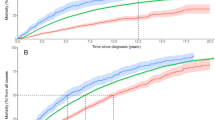Abstract
Background
This study aimed to identify preoperative parameters for predicting cancer-specific survival (CSS) in patients with upper urinary tract urothelial carcinoma (UTUC) who have undergone radical nephroureterectomy (RNU).
Methods
The preoperative clinical and laboratory records of 357 UTUC patients who underwent RNU at three different institutions were retrospectively reviewed (256, training set; 101, test set). Univariate and multivariate analyses were performed on the training set data to identify preoperative prognostic factors, using which a risk stratification model was developed. The model was validated using test set data.
Results
In univariate analysis, clinical T stage classification and preoperative concentrations of hemoglobin, C-reactive protein, sodium, and albumin showed significant association with CSS. Multivariate analysis showed that low preoperative sodium and hemoglobin concentrations were significantly associated with a poor prognosis. A risk stratification model was developed using the preoperative sodium (<141 mEq/L) and hemoglobin concentrations (below normal). Three subgroups were formed depending on the presence of no (favorable group), one (intermediate), or two (poor) prognostic factors, and the 5-year CSS estimates were found to be 96.5, 75.5, and 47.0 %, respectively (P < 0.01). The risk model was significantly associated with the adverse pathological findings of stage pT3 or more and lymphovascular invasion (P = 0.005).
Conclusion
We identified low preoperative sodium and hemoglobin concentrations as prognostic factors for patients with UTUC treated with RNU. Our risk stratification model may help physicians design a therapeutic strategy.


Similar content being viewed by others
References
Audenet F, Yates DR, Cussenot O et al (2013) The role of chemotherapy in the treatment of urothelial cell carcinoma of the upper urinary tract (UUT-UCC). Urol Oncol 31:407–413
Kaag MG, O’Malley RL, O’Malley P et al (2010) Changes in renal function following nephroureterectomy may affect the use of perioperative chemotherapy. Eur Urol 58:581–587
Babjuk M, Compe E, Zigeuner R et al (2013) European guidelines on upper tract urothelial carcinomas: 2013 update. Eur Urol 63:1059–1071
Margulis V, Shariat SF, Matin SF et al (2009) Outcomes of radical nephroureterectomy: a series from the upper tract urothelial carcinoma collaboration. Cancer 115:1224–1233
Sakano S, Matsuyama H, Kamiryo Y et al (2013) Risk group stratification based on preoperative factors to predict survival after nephroureterectomy in patients with upper urinary tract urothelial carcinoma. Ann Surg Oncol 20:4389–4396
Fujita K, Tanigawa G, Imamura R et al (2013) Preoperative serum sodium is associated with cancer-specific survival in patients with upper urinary tract urothelial carcinoma treated by nephroureterectomy. Int J Urol 20:594–601
Scolieri MJ, Paik ML, Brown SL et al (2000) Limitations of computed tomography in the preoperative staging of upper tract urothelial carcinoma. Urology 56:930–934
Ng CK, Shariat SF, Lucas SM et al (2011) Does the presence of hydronephrosis on preoperative axial CT imaging predict worse outcomes for patients undergoing nephroureterectomy for upper-tract urothelial carcinoma? Urol Oncol 29:27–32
Cho KS, Hong SJ, Cho NH et al (2007) Grade of hydronephrosis and tumor diameter as preoperative prognostic factors in ureteral transitional cell carcinoma. Urology 70:662–666
Vasudev NS, Brown JE, Brown SR et al (2008) Prognostic factors in renal cell carcinoma: association of preoperative sodium concentration with survival. Clin Cancer Res 14:1775–1781
Jeppesen AN, Jensen HK, Donskov F et al (2010) Hyponatremia as a prognostic and predictive factor in metastatic renal cell carcinoma. Br J Cancer 102:867–872
Kawashima A, Tsujimura A, Takayama H et al (2012) Impact of hyponatremia on survival of patients with metastatic renal cell carcinoma treated with molecular targeted therapy. Int J Urol 19:1050–1057
Huo T-I, Lin H-C, Hsia C-Y et al (2008) The MELD-Na is an independent short- and long-term prognostic predictor for hepatocellular carcinoma: a prospective survey. Dig Liver Dis 40:882–889
Swart RM, Hoorn EJ, Betjes MG et al (2011) Hyponatremia and inflammation: the emerging role of interleukin-6 in osmoregulation. Nephron Physiol 118:45–51
Dicato M, Plawny L, Diederich M (2010) Anemia in cancer. Ann Oncol 21(Suppl 7):vii167–vii172
Akdogan B, Dogan HS, Eskicorapci SY et al (2006) Prognostic significance of bladder tumor history and tumor location in upper tract transitional cell carcinoma. J Urol 176:48–52. doi:10.1016/S0022-5347(06)00511-8
Obata J, Kikuchi E, Tanaka N et al (2013) C-reactive protein: a biomarker of survival in patients with localized upper tract urothelial carcinoma treated with radical nephroureterectomy. Urol Oncol 31:1725–1730
Guthrie GJK, Roxburgh CSD, Horgan PG et al (2013) Does interleukin-6 link explain the link between tumour necrosis, local and systemic inflammatory responses and outcome in patients with colorectal cancer? Cancer Treat Rev 39:89–96
Mitra AP, Pagliarulo V, Yang D et al (2013) Generation of a concise gene panel for outcome prediction in urinary bladder cancer. J Clin Oncol 27:3929–3937
Seguchi T, Yokokawa K, Sugao H et al (1992) Interleukin-6 activity in urine and serum in patients with bladder carcinoma. J Urol 148:791–794
Conflict of interest
Norio Nonomura received lecture fees from Novartis Pharma and Pfizer Pharmaceutical.
Author information
Authors and Affiliations
Corresponding author
About this article
Cite this article
Fujita, K., Uemura, M., Yamamoto, Y. et al. Preoperative risk stratification for cancer-specific survival of patients with upper urinary tract urothelial carcinoma treated by nephroureterectomy. Int J Clin Oncol 20, 156–163 (2015). https://doi.org/10.1007/s10147-014-0695-1
Received:
Accepted:
Published:
Issue Date:
DOI: https://doi.org/10.1007/s10147-014-0695-1




